Debris Removal Requires a Cooperative Effort
Release Date: November 7, 2005
Release Number: 1604-117
» More Information on Mississippi Hurricane Katrina
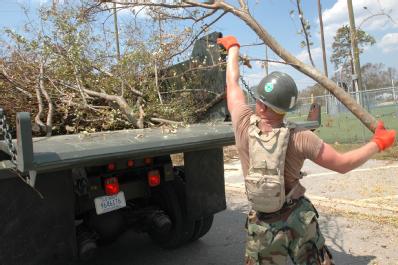 Pascagoula, Miss., September 9, 2005 -- Navy Seabees from Gulfport, Miss. cleanup debris in Pascagoula. Hurricane Katrina left extensive debris all along the Mississippi gulf coast. FEMA/Mark Wolfe FEMA/Mark Wolfe |
||
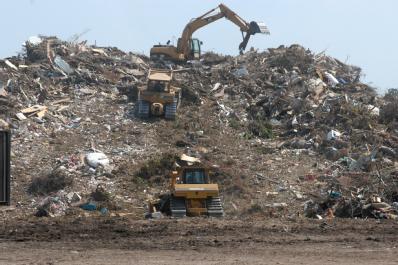 Gautier, Miss., September 14, 2005 -- The USACE US Army Corps of Engineers has set up a temporary debris site in Gautier, Miss. Hurricane Katrina left behind a huge amount of debris. FEMA/Mark Wolfe |
||
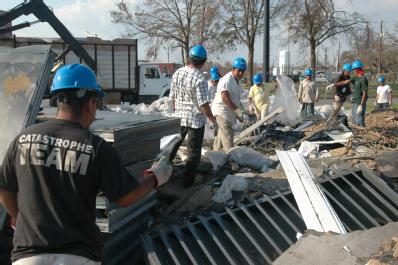 Gulfport, Miss., September 8, 2005 -- Workers cleanup debris outside Memorial Hospital in Gulfport, Miss. Hurricane Katrina caused extensive damage all along the Mississippi gulf coast. FEMA/Mark Wolfe |
||
 D'Iberville, Ms., September 29, 2005 -- Burning of vegetative debris from Hurricane Katrina. Earthmoving equipment operates at a burn pit near Biloxi, Miss. used specifically for vegetative debris as a result of Hurricane Katrina. It has been estimated that Hurricane Katrina created 50 million cubic yards of debris in Mississippi. |
||
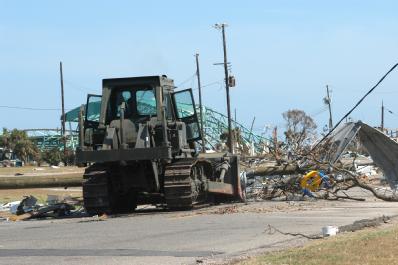 Gulfport, Miss., September 7, 2005 -- A member of the National Guard cleanups debris in Gulfport, Miss. Hurricane Katrina caused extensive damage all along the Mississippi gulf coast. FEMA/Mark Wolfe |
||
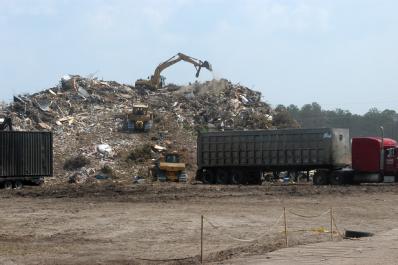 Gautier, Miss., September 14, 2005 -- The USACE has set up a temporary debris site in Gautier, Miss. Hurricane Katrina left behind a huge amount of debris. FEMA/Mark Wolfe |
||
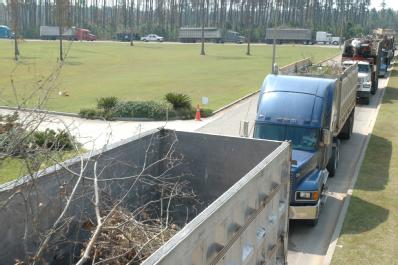 Gautier, Miss., September 14, 2005 -- Trucks line up at the USACE temporary debris site in Gautier, Miss., Hurricane Katrina left extensive debris throughout Mississippi. FEMA/Mark Wolfe |
JACKSON, Miss. -- Removing debris left by Hurricane Katrina requires a cooperative effort between several government agencies. As part of the Public Assistance program, debris removal is a critical step in the Department of Homeland Security's Federal Emergency Management Agency's (FEMA) ongoing effort to assist local governments and their residents following the destruction caused by Hurricane Katrina. FEMA and the Mississippi Emergency Management Agency (MEMA) are orchestrating and monitoring debris operations while ensuring that guidelines are followed for the debris removed from public and private lands and waterways.
Hurricane Katrina created more than 42 million cubic yards of debris in Mississippi, of which more than 17 million cubic yards have been removed as of Nov. 4. After working for two months to remove debris, estimates are the job is 42 percent complete, and at that rate it will six months to remove everything.
The most commonly used method of acquiring assistance for debris removal is through the FEMA Public Assistance program. FEMA can either reimburse local governments for the cost of debris removal or the local government can request direct federal assistance from FEMA, which then tasks the U.S. Army Corps of Engineers to complete the debris removal process.
Another government agency involved in debris removal is the U.S. Department of Agriculture (USDA). There are two programs within the USDA which provide assistance with the removal of debris from land or water generally used for agricultural purposes. The Natural Resources Conservation Service (NRCS) removes imminent hazards to life and property created by a natural disaster; including removing debris in streams and debris effecting watersheds. The NRCS works with private property owners and local governments who qualify for the program to clear the waterways. Another resource for owners of agricultural land is the USDA's Farm Service Agency (FSA), which provides emergency loans to help farmers in the recovery of losses due to the hurricane, including debris removal.
The Mississippi Department of Marine Resources (MDMR) administers the State's Derelict Vessel program, aimed at removing sunken and stranded vessels that may pose a hazard to navigation or public health. The department, with assistance from its federal partners will focus on identifying and removing such vessels sunken or stranded by Hurricane Katrina in the next several months.
The Environmental Protection Agency (EPA) and the U.S. Coast Guard (USCG) are responsible for coordinating and overseeing the proper collection and disposal of hazardous wastes as a result of the storm. USCG oversees cleanup of hazardous waste in U.S. waterways. If private property owners find hazardous debris on their property, it should be separated from other debris and disposed of at the established neighborhood collection points for hazardous waste. EPA, Mississippi Department of Environmental Quality, and county governments are establishing household hazardous waste collection days for neighborhoods along the Mississippi coast. Unknown hazardous debris, such as an unidentifiable drum, should be reported to the local government or the National Response Center (1-800-424-8802) and EPA will respond by identifying the debris and coordinating removal.
The Mississippi Department of Transportation (MDOT) is also involved in efforts to remove debris with projects along state maintained highways. Following Katrina, MDOT immediately signed contracts with approximately 14 contractors to clean up debris in the southern counties of Mississippi. At this point, all highways have been cleared of debris, and approximately 95 percent of rights of way have been cleaned.
FEMA removes only debris which was caused by the hurricane and is a threat to human health and public safety. Generally, all debris that is on government right of ways including public roads and parks is removed. Debris is also removed from waterways which are government right of ways, such as bridges and government owned boat landings.
Because of the scope of this disaster, debris will also be removed from private property if it is a threat to public health and safety in this disaster. This includes residential property debris which has been specifically identified by state and local governments as a public health and safety threat. Common public health threats are debris with bio-hazards or debris that will allow fires to spread between buildings. Common safety threats are trees and hanging limbs that create a dangerous situation when entering and exiting a property. Private and commercial property owners can also clear debris from their land and place it curbside to be picked up for proper disposal.
Those local governments who have requested debris removal on private property may also identify commercial properties in need of debris removal if there is debris creating an immediate public health and safety threat.
FEMA cannot duplicate assistance from an insurance company or other government agencies. Commercial property is generally covered by insurance and owners should contact their insurance companies for assistance. The Small Business Administration may offer loans to commercial property owners who need assistance with debris removal.
FEMA will reimburse 100 percent for debris removal tasked through the Nov. 26 deadline.
If you have questions about debris removal, FEMA has assigned a debris specialist to each county to work with state and local officials. Contact your state and local government and they can get you in touch with a debris specialist, who can provide technical assistance on debris issues.
Last Modified: Tuesday, 08-Nov-2005 10:48:53

